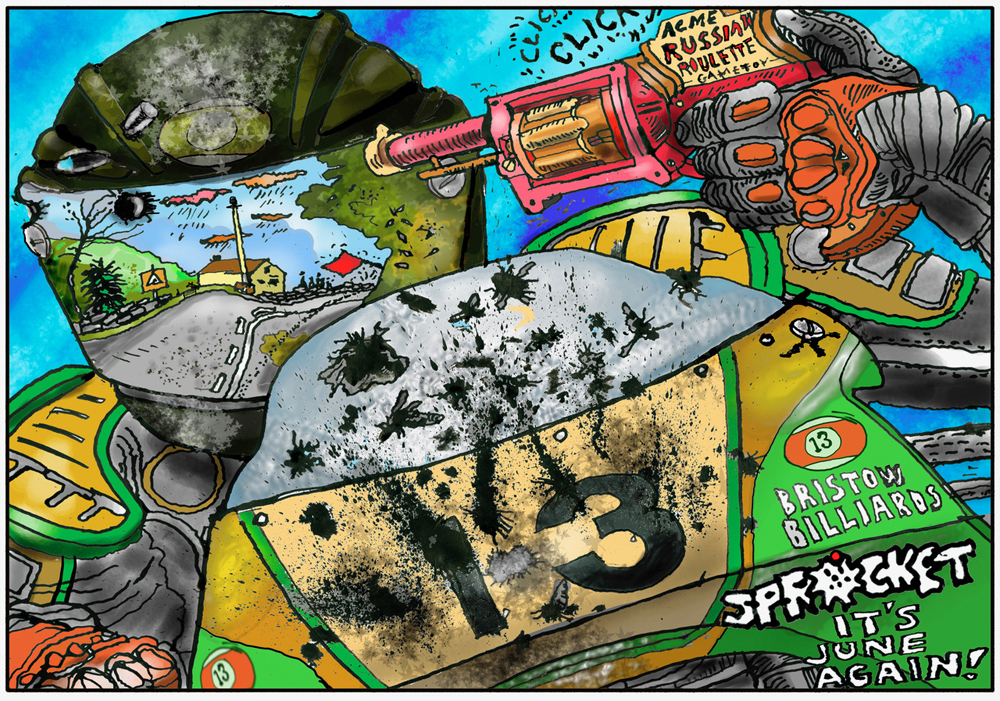Michael Scott | June 5, 2018
Motorcycle Roulette
COLUMN

It started well over 100 years ago. 1907, to be precise. And it has just started again, like clockwork, as June heralds the approach of the northern summer solstice. It is, of course, the Isle of Man TT. Most venerable of all motorsports events, and the most extraordinary and profound. In so many ways.
A British colleague once called the TT as “a sort of horizontal Everest.” I wished I’d thought that up.
Like Everest, the 37.75-miles of the Mountain Course are celebrated in triumph, but also stained with blood and monuments. Like Everest, it nonetheless exerts an irresistible pull on professional and amateur alike.
Because it’s there?
Stripped of championship status in the mid-1970s, the TT has survived triumphantly for competitors and fans (something like 50,000 of them). For them, it has not sacrificed its place, standing proud over the skyline.
TT riders, from the very fast to the amateur plodders, must also be regarded as outstanding.
Outstandingly stupid?
This is not an unusual accusation. Over the years, they have often been denigrated as ridiculously foolish takers of ridiculous risks. There are no second chances at the TT: no run-off areas, or gravel traps. Just curbs, stone walls, trees and bus stops. When it lost world championship status there was no longer any hint of compulsion. So they must be idiotic.
This is, of course, absolutely true. For people whose biggest ever risk was to go to a business meeting without a spare pencil.
But there are caveats. For some years after the downgrade, it was for many riders the money-maker that paid for GP racing; where they were paid almost nothing. Success at the TT was well-rewarded. Road-racing crashes accounted for several such, including the first American GP winner Pat Hennen, whose factory Suzuki contract required his participation.
This situation no longer prevails. The compulsion for today’s TT riders comes from within. It’s voluntary, and any wounds suffered therefore self-inflicted. But every individual has the right to make this choice, and plentiful competitors are voting with their twist-grips.
My own feelings are mixed. Like any motorcyclist who has ever been there, I love the location, the history, the track, and the unique challenge. I am in awe of every member of the 130 mph club, and even more so of serial winners like Dunlop, McGuinness and the especially heroic Ian Hutchinson, to mention just three of a heroic roll-call.
Unforgettable memories include Joey Dunlop’s first win, on a scruffy TZ with an extra-large fuel tank that came loose, so he had to hold in place with his knees, lying flat on the bumpy run down to Creg-ny-Baa. The aforementioned Hennen setting the first 120 mph lap. And so many more.
I’m deeply envious of the strength of mind of those who return every year, and keep going faster.
But I’m also deeply puzzled by the risk/reward assessment they make.
Other unforgettable memories reveal the gory truth about the scale of risk.
Unforgettably, I was right there in 1978 when Mac Hobson’s sidecar crashed barely a quarter-of-a-mile from the start. He and passenger Kenny Birch were killed instantly, the latter cut in two. Within minutes, a short distance further (though thankfully out of my sight), Swiss Ernst Trachsel also died.
That rather took the gloss off Mike Hailwood’s victorious return.
Eight years on, a junior school teacher/racer hit a runaway horse. A fellow teacher phoned the press office on behalf of his young pupils, glued to the radio, and baffled as to why Gene McDonnell was suddenly not being mentioned. Not sure how she told them.
That crash had two parts: the horse had been spooked by the med-evac helicopter taking another rider to hospital. Bizarrely, he was not badly injured, but the helicopter was new, and the organizers wanted to use it.
Another bizarre double-dimension incident involving the officials cast a pall over practice week this year.
It started when Manxman Dan Kneen, who had joined the 130-club in 2017, became the first fatality of the year. The red flags came out, riders who had not yet reached the crash site, more than halfway round approaching Ramsey, were sent back to the pits in reverse direction—but an official course car was coming the other way, at speed. A second rider, one Steve Mercer, collided with it head on, and sustained critical injuries.
There are many other names, many other ghastly stories. I could go on, but I don’t want to be accused of morbid fascination.
Instead, I stand back, fingers crossed and eyes narrowed, full of hope and pity and muddle-headed admiration. And promise never to use the insulting cliche: that the classic circuit’s 250-plus victims “died doing what they loved.”
What, crashing into stone walls?
They lived doing what they loved. They died when it went horribly wrong.
RIP, all of them. CN